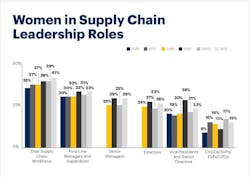The number of women holding supply chain jobs has increased. A survey, The Women in Supply Chain Survey 2021 by Gartner and AWESOME, which interviewed 223 supply chain organizations from February through March 2021, discovered that the percentage of women in the .supply chain workforce was at the highest level since the first edition of the survey in 2016.
Women comprised 41% of the supply chain workforce in 2021, up from 39% in 2020, according to a recent survey by Gartner, Inc. Every leadership level saw an increase in representation, except the executive level where there has been a slight decline. In 2021, women account for 15% of executive-level roles, down from 17% in 2020.
"Contrary to other industries, supply chain’s mission-criticality during the COVID-19 pandemic has meant that many sectors did not reduce their workforce, but rather continued to hire and even faced talent shortages, especially in the product supply chains," said Dana Stiffler, vice president analyst with the Gartner Supply Chain practice. "This resulted in many women not only standing their ground in supply chain organizations but increasing their representation in organizations. We also recorded a record number of specific commitments and supply chain-led actions and saw existing programs starting to pay off."
Retaining Midcareer Women Poses Biggest Challenge
The pandemic does not appear to have disrupted supply chain gender equality efforts, according to the survey. Eighty-four percent of responding organizations stated that COVID-19 had no discernible impact on their ability to retain and advance women.
However, 54% of survey respondents said that retaining midcareer women is an increasing challenge. Lack of career opportunities is the top reason that midcareer women left a supply chain organization or provider. The second-most selected option was development opportunities.
"Supply chain leaders who are serious about their gender equality efforts must create tailored leadership development programs and explore flexible work policies that cater to the needs of mid-career women," Ms. Stiffler said.
More Organizations Are Setting Goals for Gender Diversity and Start Initiatives
Previous years have shown that setting goals and having stated objectives are crucial drivers for improvements in pipelines and other DEI outcomes. In 2021, the proportion of supply chain organizations with any type of goal jumped to 73% from 64% in 2020. Within the subset of respondents (29%) who have stated objectives, 68% said the supply chain organization had a targeted initiative focused on women, a huge step up from 46% in 2020.
"It's encouraging to see that the larger share of this jump was for more formal targets and specific goals on management scorecards. For these respondents, there is greater accountability for results — and we see the correlation with stronger representation and inclusion showing up in pipelines," Ms. Stiffler concluded.

